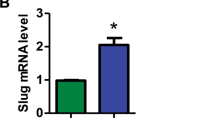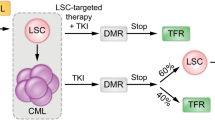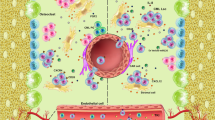Abstract
A therapeutic strategy for treating cancer is to target and eradicate cancer stem cells (CSCs) without harming their normal stem cell counterparts. The success of this approach relies on the identification of molecular pathways that selectively regulate CSC function. Using BCR-ABL–induced chronic myeloid leukemia (CML) as a disease model for CSCs, we show that BCR-ABL downregulates the Blk gene (encoding B-lymphoid kinase) through c-Myc in leukemic stem cells (LSCs) in CML mice and that Blk functions as a tumor suppressor in LSCs but does not affect normal hematopoietic stem cells (HSCs) or hematopoiesis. Blk suppresses LSC function through a pathway involving an upstream regulator, Pax5, and a downstream effector, p27. Inhibition of this Blk pathway accelerates CML development, whereas increased activity of the Blk pathway delays CML development. Blk also suppresses the proliferation of human CML stem cells. Our results show the feasibility of selectively targeting LSCs, an approach that should be applicable to other cancers.
This is a preview of subscription content, access via your institution
Access options
Subscribe to this journal
Receive 12 print issues and online access
$209.00 per year
only $17.42 per issue
Buy this article
- Purchase on Springer Link
- Instant access to full article PDF
Prices may be subject to local taxes which are calculated during checkout








Similar content being viewed by others
References
Huntly, B.J. & Gilliland, D.G. Leukaemia stem cells and the evolution of cancer-stem-cell research. Nat. Rev. Cancer 5, 311–321 (2005).
Reya, T., Morrison, S.J., Clarke, M.F. & Weissman, I.L. Stem cells, cancer, and cancer stem cells. Nature 414, 105–111 (2001).
Visvader, J.E. & Lindeman, G.J. Cancer stem cells in solid tumours: accumulating evidence and unresolved questions. Nat. Rev. Cancer 8, 755–768 (2008).
Wang, J.C. & Dick, J.E. Cancer stem cells: lessons from leukemia. Trends Cell Biol. 15, 494–501 (2005).
Chen, Y., Hu, Y., Zhang, H., Peng, C. & Li, S. Loss of the Alox5 gene impairs leukemia stem cells and prevents chronic myeloid leukemia. Nat. Genet. 41, 783–792 (2009).
Hu, Y. et al. Targeting multiple kinase pathways in leukemic progenitors and stem cells is essential for improved treatment of Ph+ leukemia in mice. Proc. Natl. Acad. Sci. USA 103, 16870–16875 (2006).
Melo, J.V. & Barnes, D.J. Chronic myeloid leukaemia as a model of disease evolution in human cancer. Nat. Rev. Cancer 7, 441–453 (2007).
Ren, R. Mechanisms of BCR-ABL in the pathogenesis of chronic myelogenous leukaemia. Nat. Rev. Cancer 5, 172–183 (2005).
Wong, S. & Witte, O.N. The BCR-ABL story: bench to bedside and back. Annu. Rev. Immunol. 22, 247–306 (2004).
Druker, B.J. et al. Efficacy and safety of a specific inhibitor of the BCR-ABL tyrosine kinase in chronic myeloid leukemia. N. Engl. J. Med. 344, 1031–1037 (2001).
Kantarjian, H. et al. Hematologic and cytogenetic responses to imatinib mesylate in chronic myelogenous leukemia. N. Engl. J. Med. 346, 645–652 (2002).
Talpaz, M. et al. Dasatinib in imatinib-resistant Philadelphia chromosome–positive leukemias. N. Engl. J. Med. 354, 2531–2541 (2006).
Graham, S.M. et al. Primitive, quiescent, Philadelphia-positive stem cells from patients with chronic myeloid leukemia are insensitive to STI571 in vitro. Blood 99, 319–325 (2002).
Corbin, A.S. et al. Human chronic myeloid leukemia stem cells are insensitive to imatinib despite inhibition of BCR-ABL activity. J. Clin. Invest. 121, 396–409 (2011).
Lessard, J. & Sauvageau, G. Bmi-1 determines the proliferative capacity of normal and leukaemic stem cells. Nature 423, 255–260 (2003).
Park, I.K. et al. Bmi-1 is required for maintenance of adult self-renewing haematopoietic stem cells. Nature 423, 302–305 (2003).
Saijo, K. et al. Essential role of Src-family protein tyrosine kinases in NF-κB activation during B cell development. Nat. Immunol. 4, 274–279 (2003).
Zwollo, P. & Desiderio, S. Specific recognition of the blk promoter by the B-lymphoid transcription factor B-cell–specific activator protein. J. Biol. Chem. 269, 15310–15317 (1994).
Nutt, S.L., Heavey, B., Rolink, A.G. & Busslinger, M. Commitment to the B-lymphoid lineage depends on the transcription factor Pax5. Nature 401, 556–562 (1999).
Xie, S., Lin, H., Sun, T. & Arlinghaus, R.B. Jak2 is involved in c-Myc induction by Bcr-Abl. Oncogene 21, 7137–7146 (2002).
Sawyers, C.L., Callahan, W. & Witte, O.N. Dominant negative MYC blocks transformation by ABL oncogenes. Cell 70, 901–910 (1992).
Notari, M. et al. A MAPK/HNRPK pathway controls BCR/ABL oncogenic potential by regulating MYC mRNA translation. Blood 107, 2507–2516 (2006).
O'Riordan, M. & Grosschedl, R. Coordinate regulation of B cell differentiation by the transcription factors EBF and E2A. Immunity 11, 21–31 (1999).
Lin, H. & Grosschedl, R. Failure of B-cell differentiation in mice lacking the transcription factor EBF. Nature 376, 263–267 (1995).
Wang, H. et al. IRF8 regulates B-cell lineage specification, commitment, and differentiation. Blood 112, 4028–4038 (2008).
Wang, H. & Morse, H.C. III. IRF8 regulates myeloid and B lymphoid lineage diversification. Immunol. Res. 43, 109–117 (2009).
Xia, Z.B. et al. The MLL fusion gene, MLL-AF4, regulates cyclin-dependent kinase inhibitor CDKN1B (p27kip1) expression. Proc. Natl. Acad. Sci. USA 102, 14028–14033 (2005).
Andreu, E.J. et al. BCR-ABL induces the expression of Skp2 through the PI3K pathway to promote p27Kip1 degradation and proliferation of chronic myelogenous leukemia cells. Cancer Res. 65, 3264–3272 (2005).
Chu, I. et al. p27 phosphorylation by Src regulates inhibition of cyclin E–Cdk2. Cell 128, 281–294 (2007).
Grimmler, M. et al. Cdk-inhibitory activity and stability of p27Kip1 are directly regulated by oncogenic tyrosine kinases. Cell 128, 269–280 (2007).
Jonuleit, T. et al. Bcr-Abl kinase down-regulates cyclin-dependent kinase inhibitor p27 in human and murine cell lines. Blood 96, 1933–1939 (2000).
Rangatia, J. & Bonnet, D. Transient or long-term silencing of BCR-ABL alone induces cell cycle and proliferation arrest, apoptosis and differentiation. Leukemia 20, 68–76 (2006).
Oda, H., Kumar, S. & Howley, P.M. Regulation of the Src family tyrosine kinase Blk through E6AP-mediated ubiquitination. Proc. Natl. Acad. Sci. USA 96, 9557–9562 (1999).
Frescas, D. & Pagano, M. Deregulated proteolysis by the F-box proteins SKP2 and β-TrCP: tipping the scales of cancer. Nat. Rev. Cancer 8, 438–449 (2008).
Agarwal, A. et al. Absence of SKP2 expression attenuates BCR-ABL–induced myeloproliferative disease. Blood 112, 1960–1970 (2008).
Radich, J.P. et al. Gene expression changes associated with progression and response in chronic myeloid leukemia. Proc. Natl. Acad. Sci. USA 103, 2794–2799 (2006).
Zhang, B. et al. Effective targeting of quiescent chronic myelogenous leukemia stem cells by histone deacetylase inhibitors in combination with imatinib mesylate. Cancer Cell 17, 427–442 (2010).
Affer, M. et al. Gene expression differences between enriched normal and chronic myelogenous leukemia quiescent stem/progenitor cells and correlations with biological abnormalities. J. Oncol. 2011, 798592 (2011).
Nordon, R.E., Ginsberg, S.S. & Eaves, C.J. High-resolution cell division tracking demonstrates the FLt3-ligand-dependence of human marrow CD34+CD38− cell production in vitro. Br. J. Haematol. 98, 528–539 (1997).
Heaney, N.B. et al. Bortezomib induces apoptosis in primitive chronic myeloid leukemia cells including LTC-IC and NOD/SCID repopulating cells. Blood 115, 2241–2250 (2010).
Bhatia, R. et al. Persistence of malignant hematopoietic progenitors in chronic myelogenous leukemia patients in complete cytogenetic remission following imatinib mesylate treatment. Blood 101, 4701–4707 (2003).
Dierks, C. et al. Expansion of Bcr-Abl–positive leukemic stem cells is dependent on Hedgehog pathway activation. Cancer Cell 14, 238–249 (2008).
Kirstetter, P., Anderson, K., Porse, B.T., Jacobsen, S.E. & Nerlov, C. Activation of the canonical Wnt pathway leads to loss of hematopoietic stem cell repopulation and multilineage differentiation block. Nat. Immunol. 7, 1048–1056 (2006).
Scheller, M. et al. Hematopoietic stem cell and multilineage defects generated by constitutive β-catenin activation. Nat. Immunol. 7, 1037–1047 (2006).
Zhao, C. et al. Loss of β-catenin impairs the renewal of normal and CML stem cells in vivo. Cancer Cell 12, 528–541 (2007).
Zhao, C. et al. Hedgehog signalling is essential for maintenance of cancer stem cells in myeloid leukaemia. Nature 458, 776–779 (2009).
Hu, Y., Chen, Y., Douglas, L. & Li, S. β-catenin is essential for survival of leukemic stem cells insensitive to kinase inhibition in mice with BCR-ABL–induced chronic myeloid leukemia. Leukemia 23, 109–116 (2009).
Hu, Y. et al. Requirement of Src kinases Lyn, Hck and Fgr for BCR-ABL1–induced B-lymphoblastic leukemia but not chronic myeloid leukemia. Nat. Genet. 36, 453–461 (2004).
Warmuth, M. et al. The Src family kinase Hck interacts with Bcr-Abl by a kinase-independent mechanism and phosphorylates the Grb2-binding site of Bcr. J. Biol. Chem. 272, 33260–33270 (1997).
Wu, J. et al. Lyn regulates BCR-ABL and Gab2 tyrosine phosphorylation and c-Cbl protein stability in imatinib-resistant chronic myelogenous leukemia cells. Blood 111, 3821–3829 (2008).
Xiao, W., Hong, H., Kawakami, Y., Lowell, C.A. & Kawakami, T. Regulation of myeloproliferation and M2 macrophage programming in mice by Lyn/Hck, SHIP, and Stat5. J. Clin. Invest. 118, 924–934 (2008).
Cobaleda, C., Schebesta, A., Delogu, A. & Busslinger, M. Pax5: the guardian of B cell identity and function. Nat. Immunol. 8, 463–470 (2007).
Mullighan, C.G. et al. Genome-wide analysis of genetic alterations in acute lymphoblastic leukaemia. Nature 446, 758–764 (2007).
Mullighan, C.G. et al. Deletion of IKZF1 and prognosis in acute lymphoblastic leukemia. N. Engl. J. Med. 360, 470–480 (2009).
Cheng, T., Rodrigues, N., Dombkowski, D., Stier, S. & Scadden, D.T. Stem cell repopulation efficiency but not pool size is governed by p27kip1. Nat. Med. 6, 1235–1240 (2000).
Ramaraj, P. et al. Effect of mutational inactivation of tyrosine kinase activity on BCR/ABL-induced abnormalities in cell growth and adhesion in human hematopoietic progenitors. Cancer Res. 64, 5322–5331 (2004).
Copland, M. et al. BMS-214662 potently induces apoptosis of chronic myeloid leukemia stem and progenitor cells and synergizes with tyrosine kinase inhibitors. Blood 111, 2843–2853 (2008).
Li, S., Ilaria, R.L. Jr., Million, R.P., Daley, G.Q. & Van Etten, R.A. The P190, P210, and P230 forms of the BCR/ABL oncogene induce a similar chronic myeloid leukemia–like syndrome in mice but have different lymphoid leukemogenic activity. J. Exp. Med. 189, 1399–1412 (1999).
Peng, C. et al. Inhibition of heat shock protein 90 prolongs survival of mice with BCR-ABL-T315I–induced leukemia and suppresses leukemic stem cells. Blood 110, 678–685 (2007).
Acknowledgements
We thank A. Tarakhovsky (Rockefeller University) for providing Blk−/− mice and K. Calame (Columbia University) for pGL3-Pax5 plasmid. We thank S. Deibler for editorial assistance. This work was supported by grants from the Leukemia & Lymphoma Society and the US National Institutes of Health (NIH) (R01-CA122142 and R01-CA114199) to S.L. M.A.B. was supported by the NIH (AI46629). S.L. is a Scholar of the Leukemia & Lymphoma Society.
Author information
Authors and Affiliations
Contributions
H.Z. designed and performed experiments, analyzed data and wrote the paper. C.P., Y.H., H.L., Y.C., C.S., Z.S., J.C., L.H., A.H., P.M. and M.A.B. helped with experiments. X.Z. and D.L. helped analyze microarray data. M.R.G. helped design experiments and write the paper. S.L. designed experiments, analyzed data and wrote the paper.
Corresponding author
Ethics declarations
Competing interests
The authors declare no competing financial interests.
Supplementary information
Supplementary Text and Figures
Supplementary Figures 1–11, Supplementary Tables 1–3 and Supplementary Note (PDF 2462 kb)
Rights and permissions
About this article
Cite this article
Zhang, H., Peng, C., Hu, Y. et al. The Blk pathway functions as a tumor suppressor in chronic myeloid leukemia stem cells. Nat Genet 44, 861–871 (2012). https://doi.org/10.1038/ng.2350
Received:
Accepted:
Published:
Issue Date:
DOI: https://doi.org/10.1038/ng.2350
This article is cited by
-
Targeting protein lysine methyltransferase G9A impairs self-renewal of chronic myelogenous leukemia stem cells via upregulation of SOX6
Oncogene (2021)
-
Cytosolic DNA sensing by cGAS: regulation, function, and human diseases
Signal Transduction and Targeted Therapy (2021)
-
DYRK2 controls a key regulatory network in chronic myeloid leukemia stem cells
Experimental & Molecular Medicine (2020)
-
Chronic myeloid leukemia stem cells
Leukemia (2019)
-
The non-genomic loss of function of tumor suppressors: an essential role in the pathogenesis of chronic myeloid leukemia chronic phase
BMC Cancer (2016)



